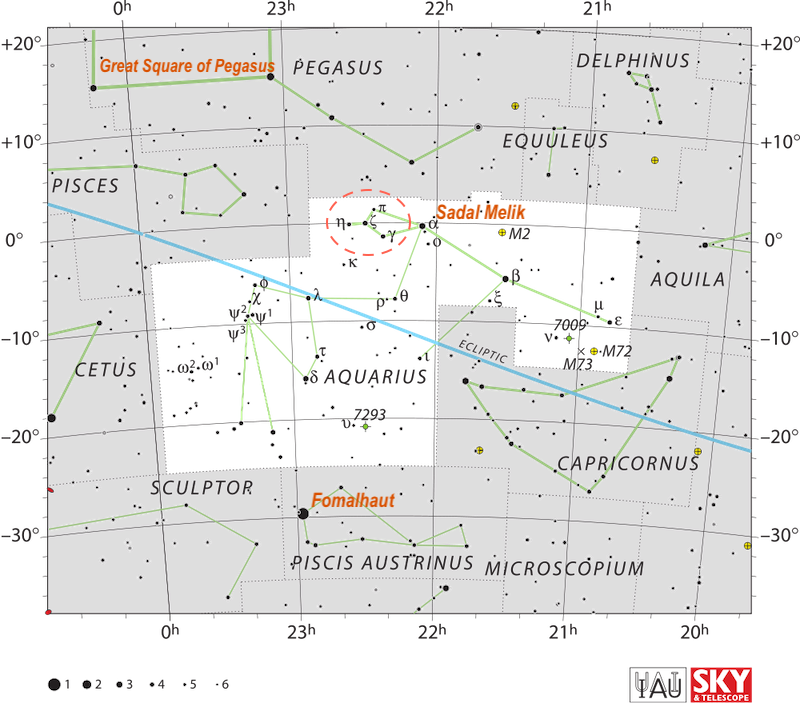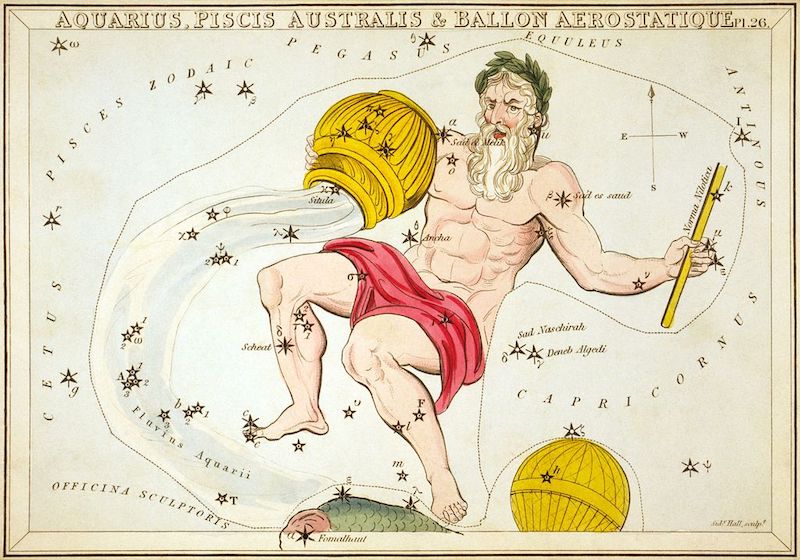
Lying on our sky’s dome between the constellations Capricornus and Pisces, Aquarius the Water Bearer is tricky to spot. There aren’t many bright stars in this constellation, and you’ll need a dark sky to get a good look at it. It’s one of the 13 constellations of the zodiac, which means the sun, moon and planets occasionally pass within its boundaries. Neptune is currently in Aquarius and will be there through early 2023. Venus will cross through Aquarius in late January and early February, brushing past Neptune on February 14 and 15, 2023.
When to see Aquarius
The best time to spot Aquarius is in the evening during a Northern Hemisphere autumn or Southern Hemisphere spring. Aquarius is just east of another zodiacal constellation, Capricornus. And you can use the Great Square of Pegasus to guide you toward Aquarius.
From northerly latitudes, this constellation appears in the southern sky. South of the equator, it’s found overhead or high in the northern sky. You’ll see Aquarius highest in the sky in early October around 10 p.m. local time (11 p.m. local daylight saving time in the U.S.). Or try one month later – in early November – around 8 p.m. local time (9 p.m. local daylight saving time in the U.S.).
A sea in the sky
Aquarius lies in a region of the sky sometimes called the Sea. This part of the sky looks dark and deep, but of course there are stars here, as there are everywhere on the heavenly globe. The stars in this part of the sky tend to be faint. In western sky lore, early stargazers associated the star patterns here with water in a celestial sea. It’s here we find Cetus the Whale, Pisces the Fish, Eridanus the River, and Piscis Austrinus the Southern Fish.
The brightest star in this “watery” region of the sky is Fomalhaut in Piscis Austrinus the Southern Fish. Aquarius the Water Bearer is usually portrayed as a man pouring a stream of water into the mouth of the Southern Fish, which is interesting since fish don’t drink water. In the sky, you’ll see a zigzag line of stars leading from Aquarius to Fomalhaut, the only bright star in the Celestial Sea. By the way, because it’s in such an apparently empty part of the sky, Fomalhaut is sometimes called the Loneliest Star.
The stars of Aquarius
The two brightest stars in Aquarius are the magnitude 2.9 Beta Aquarii, or Sadalsuud, and the magnitude 2.95 Alpha Aquarii, or Sadalmelik. The two stars are ten degrees apart, or about the width of your fist held at arm’s length. The next brightest star is magnitude 3.27 Delta Aquarii, or Skat. A triple star (visual only, not physically related) is the stars of Psi Aquarii. Their magnitudes range from 4.2 to 4.9.
If your sky is dark enough, you can see a little asterism – or noticeable pattern of stars within Aquarius – just to the left of the star Sadalmelik. This little pattern, shown within the orange dashed oval in the star map, is called the Water Jar in Aquarius. Imagine a cascade of faint stars as water, visible in very dark skies, making a zigzag stream of stars, flowing down toward Fomalhaut.

Deep-sky treasures in Aquarius
Aquarius is home to a number of Messier objects, including both clusters and nebulae.
The globular cluster M2 resides in Aquarius. M2 is above a line drawn between the Alpha and Beta stars. This globular cluster shines at magnitude 6.5 and lies about 37,000 light-years away. M72 is another globular cluster that can be found in Aquarius. If you draw a line from Alpha, through Beta, and extend it 11 to 12 degrees forward, you’ll run into M72. While you can see M2 with binoculars, M72 is magnitude 9.4, so you’ll need a telescope. M72 lies 55,000 light-years away. An open cluster in the same area as M72 is M73, just over 1 degree east from the globular cluster. It shines a bit brighter at magnitude 9 but is a smaller and less noticeable grouping of stars.
Close to M72 and M73 is the Saturn Nebula, or NGC 7009. This 8th-magnitude planetary nebula looks like the planet Saturn because its gassy halo includes a thin extension on both sides that look like rings. Another well-known nebula, the Helix Nebula (NGC 7293) lies in Aquarius. The Helix lies about 20 degrees below the stars Alpha and Beta. Although the Helix is magnitude 7.3, it’s hard to observe because its light extends over a large space. This nebula spreads out across 28 arcminutes, almost as large as a full moon. However, its appearance in photographs is quite stunning.
Aquarius in history and star lore
Aquarius is tied to an abundance of water, sometimes as a blessing and sometimes as a curse.
Greek mythology associates Aquarius with the deluge that wiped out all of humanity except for Deucalion and his wife Pyrrha. Zeus, king of the gods, unleashed the flood to punish people for their misdeeds. But Zeus advised the virtuous Deucalion to save himself by building an ark. This tale of divine retribution strongly parallels the story of the great flood in the Old Testament.
In ancient Egypt, the constellation Aquarius represented Hapi, god of the Nile River. This benevolent god distributed the waters of life, and the urn symbolized a fount of good fortune. It’s this association that explains why the Water Bearer is often seen holding the Norma Nilotica, a rod for measuring the depth of the Nile River. Also, the names of Aquarius’ two brightest stars – Sadalmelik and Sadalsuud – reaffirm the idea of providence. The names are thought to mean lucky one of the king and luckiest of the lucky.

Dates of sun’s passage through Aquarius
As seen from Earth, the sun passes in front of the constellation Aquarius from about February 16 to March 12. It is important to note that these dates are in reference to the constellation – not the sign – Aquarius. The sun is in the sign Aquarius from about January 20 to February 18. (A constellation of the zodiac refers to certain section of the starry sky. On the other hand, a sign of the zodiac refers to the seasonal position of the sun, irrespective of what constellation backdrops the sun at a given season.)
You’ve no doubt heard the song The Age of Aquarius. Learn more about what that phrase means here.
Bottom line: Aquarius the Water Bearer is a faint zodiacal constellation, best seen in a dark sky.
The constellations of the zodiac
Meet Taurus the Bull in the evening sky
Meet Gemini the Twins, home to 2 bright stars
Meet Cancer the Crab and its Beehive Cluster
Leo the Lion and its backward question mark
Virgo the Maiden in northern spring skies
Meet Libra the Scales, a zodiacal constellation
Scorpius the Scorpion is a summertime delight
Sagittarius the Archer and its famous Teapot
Capricornus the Sea-goat has an arrowhead shape
Meet Aquarius the Water Bearer and its stars
Meet Pisces the Fish, 1st constellation of the zodiac
Say hello to Aries the Ram
Born under the sign of Ophiuchus?











